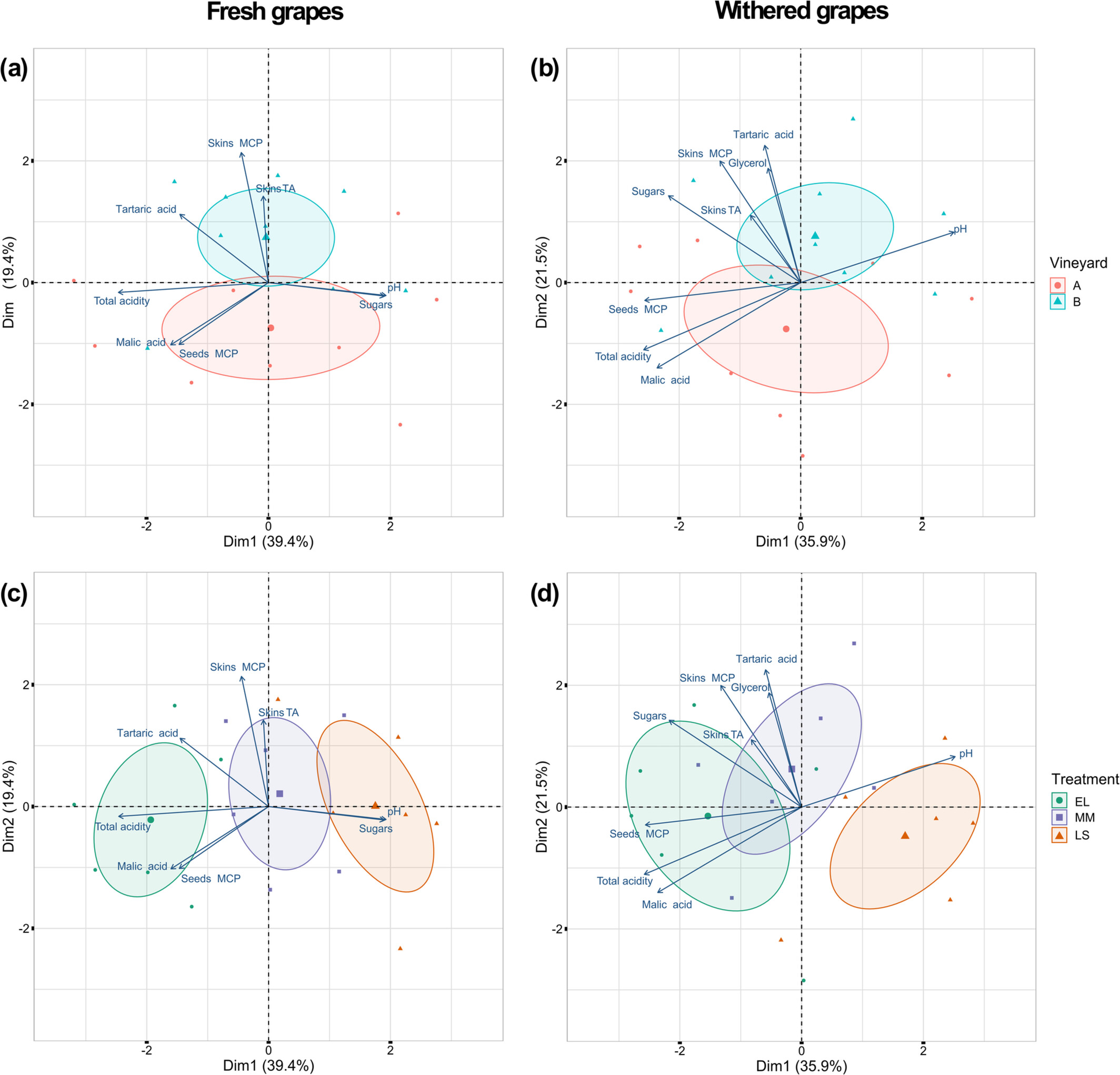Articolo su rivista pubblicato in Journal of the Science of Food and Agriculture, volume 103, pp. 6105–6118.
Autori: .
Abstract
Background: Sforzato di Valtellina (Sfursat) is a PDO reinforced red wine produced in Valtellina (northern Italy) from partially withered red grapes (Vitis vinifera L.) cv. Nebbiolo. The present study aimed to evaluate the combined influence of different grape ripeness levels and withering length on the chemical composition, mechanical properties, and phenolic profile of Nebbiolo winegrapes from two Valtellina vineyards. During three consecutive vintages (2019, 2020, and 2021), three different technological binomials have been tested: early harvest/long withering (EL), medium-term harvest/medium-term withering (MM), and late harvest/short withering (LS). Results: At the end of the withering process, EL thesis usually presented the highest values of sugars and acidity. Extractable seed polyphenols showed a decreasing trend by leaving the grapes on the plant longer, and this effect increased considerably after withering with respect to fresh samples. EL and MM evidenced the greater concentration of these compounds expressed on grape weight, particularly for tannins. Instead, skin-extracted total phenolics were less influenced by the harvest time, whereas their concentration increased after withering. The harvest time appears to have a higher impact than the withering length on the final extractable anthocyanin content, although the trend was no stable during the vintages or common for the two vineyards evaluated. EL and MM experienced the highest contents of grape skin tannins in most cases, suggesting that a longer withering increases their concentration. Conclusion: Harvest time and withering length can be modulated according to the desired oenological objective, promoting the valorization of grape potentialities. The choice to harvest the grapes earlier and enhance the withering length should be preferred to obtain wines with higher acidity and phenolic content, more suitable for long-ageing period.
Parole chiave grape postharvest, phenolic compounds, withering process, red winegrapes, reinforced wines, Sforzato di Valtellina DOCG
codice BibTeX: clicca per mostrare
@article{
2318_1904277,
url = {https://hdl.handle.net/2318/1904277},
author = {Scalzini, Giulia and Giacosa, Simone and Paissoni, Maria Alessandra and Río Segade, Susana and De Paolis, Camilla and Škrab, Domen and Zava, Andrea and Motta, Giulia and Ferrero, Lorenzo and Beria D'Argentina, Sofia and Gerbi, Vincenzo and Rolle, Luca},
title = {Combined effect of harvest time and postharvest dehydration length on the composition of withered grapes for Sforzato di Valtellina DOCG wine production},
year = {2023},
journal = {Journal of the Science of Food and Agriculture},
volume = {103},
abstract = {Background: Sforzato di Valtellina (Sfursat) is a PDO reinforced red wine produced in Valtellina (northern Italy) from partially withered red grapes (Vitis vinifera L.) cv. Nebbiolo. The present study aimed to evaluate the combined influence of different grape ripeness levels and withering length on the chemical composition, mechanical properties, and phenolic profile of Nebbiolo winegrapes from two Valtellina vineyards. During three consecutive vintages (2019, 2020, and 2021), three different technological binomials have been tested: early harvest/long withering (EL), medium-term harvest/medium-term withering (MM), and late harvest/short withering (LS).
Results: At the end of the withering process, EL thesis usually presented the highest values of sugars and acidity. Extractable seed polyphenols showed a decreasing trend by leaving the grapes on the plant longer, and this effect increased considerably after withering with respect to fresh samples. EL and MM evidenced the greater concentration of these compounds expressed on grape weight, particularly for tannins. Instead, skin-extracted total phenolics were less influenced by the harvest time, whereas their concentration increased after withering. The harvest time appears to have a higher impact than the withering length on the final extractable anthocyanin content, although the trend was no stable during the vintages or common for the two vineyards evaluated. EL and MM experienced the highest contents of grape skin tannins in most cases, suggesting that a longer withering increases their concentration.
Conclusion: Harvest time and withering length can be modulated according to the desired oenological objective, promoting the valorization of grape potentialities. The choice to harvest the grapes earlier and enhance the withering length should be preferred to obtain wines with higher acidity and phenolic content, more suitable for long-ageing period.},
keywords = {grape postharvest, phenolic compounds, withering process, red winegrapes, reinforced wines, Sforzato di Valtellina DOCG},
doi = {10.1002/jsfa.12680},
pages = {6105--6118}
}
Disponibilità della pubblicazione
Open access
Il file è disponibile in versione ad accesso aperto. È quindi possibile scaricarlo e diffonderlo secondo le limitazioni espresse nella licenza.
Materiale supplementare (da IRIS): File 1
Visualizza o richiedi la pubblicazione
È possibile trovare la versione postprint dell’articolo nell’archivio istituzionale dell’Università di Torino
IRIS-AperTO record 2318/1904277
Consulta la versione finale presso l’editore:
doi:10.1002/jsfa.12680
File non disponibile? Servono informazioni?
Puoi contattarmi e richiedere il documento attraverso il seguente modulo:
